| Image search results - "TRI" |

TIBERIUS - As - 35/36 AD - Mint of Rome
Obv.: TI CAESAR DIVI AVG F AVGVST IMP VIII
Laureate head left
Rev.: PONTIF MAXIM TRIBVN POTEST XXXVII S C
Winged caduceus
g. 10,7 mm. 25,8
Cohen 22, RIC 59, Sear RCV 1771Maxentius
|
|

AS - Agrippa - 37/41 (Caligula)
Obv.: M AGRIPPA L F COS III Head left, wearing rostral crown.
Rev.: Neptune standing, head left, holding trident and little dolphin; S C at sides.
g. 10,7 mm. 28
Cohen 3, RIC 58, Sear RCV 1812Maxentius
|
|

Serrate Denarius - 79 BC.
C. NAEVIVS BALBVS - Gens Naevia
Obv.: Diademed head of Venus right, SC behind
Rev.: Victory in triga right; C NAE BALB (AE & AL in monogram) in ex.
Gs. 3,6 mm. 18,4
Crawford 382/1, Sear RCV 309
Maxentius
|
|

AR Denarius - L. MARCIVS PHILIPPVS - 113-112 BC. - Gens Îarcia - Mint of Rome
Obv.: Head of Philip V right wearing Macedonian helmet; ROMA monogram and simpulum behind, Φ forward
Rev.: Equestrian statue right, flower below horse; L. PHILIPPVS in a tablet. XVI (in monogram) in ex.
Gs. 3,6 mm. 18,3
Crawford 293/1; Sear RCV 170Maxentius
|
|
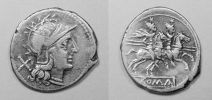
Anonymous Denarius - After 211 BC
Obv.: Helmeted head of Roma right, with triple earring, spike above visor, X behind.
Rev.: The Dioscuri riding right, ROMA in linear frame below.
Gs. 3,2 mm. 18,2x19,5
Cr44/5, Sear RCV 38
Maxentius
|
|

Denarius - 49 B.C.
L CORNELIVS LENTVLVS & C CLAVDIVS MARCELLVS - Gens Cornelia.
Obv.: Facing head of Medusa in center of triskeles, ear of corn between each leg
Rev.: Jupiter standing right with thunderbolt & eagle. LENT MAR (NT & MAR in monogram) left, COS right.
Gs. 3,5 mm. 18,4
Craw. 445/1b, Sear RCV 414.
Maxentius
|
|
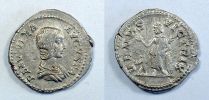
PLAVTILLA - Denarius - 204 AD
Obv.:PLAVTILLA AVGVSTA, draped bust right
Rev.: VENVS VICTRIX, Venus standing left holding apple & palm, leaning on shield, Cupid at her feet.
Gs. 3,8 mm. 19,3x20
Cohen 25, RIC 369 Maxentius
|
|

Anonymous TRIENS - After 211 B.C. (Grueber 240/229 B.C.)
Obv.:Minerva head's right. Four pellets above
Rev. Ship's prow right. ROMA above, four pellets below
Gs. 7,9 mm. 24,7
Craw. 56/4, sear RCV 911, BMRRC (Grueber) 245Maxentius
|
|
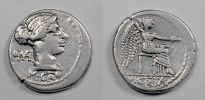
Denarius - 89 BC. - Mint of Rome
M. PORCIVS CATO - Gens Porcia
Obv.: Female bust right (Roma?). ROMA (MA in monogram) behind. M. CATO below
Rev.:Victoria seated right, holding palm and patera. In ex. VICTRIX (TR in monogram)
Gs. 3,8 mm. 17,7
Crawf. 343/1, Sear RCV 247, Grueber II 657
Maxentius
|
|

Denarius - 111/110 B.C. Rome mint
APPIVS CL. PVLCHER, T. MALLIVS - Gens Mallia - Claudia.
Obv: Helmeted head of Roma right, quadrangular device behind
Rev.: Victory in triga right, T. MAL. (in monogr.) AP. CL. Q. VR. in ex.
Gs. 3,8 mm. 17,82
Crawf. 299/1b, Sear RCV 176, Grueber 1293
For Crawford, Q. VR would not mean Quaestores Urbani, but the name of a third moneyer, Q. Urbinius.Maxentius
|
|

Denarius Serratus - 79 BC - Rome mint
Obv.: Head of Juno Sospita right, wearing goatskin, symbol behind (amphora with two handles and string)
Rev.:Gryphon dancing right, symbol below (ampulla), L PAPI in ex.
Gs. 3,8 mm. 18,28x19,64
Crawf. 384/1, Sear RCV 311, Grueber 2977
Maxentius
|
|

GALERIA VALERIA - Ã Follis - 309-310 AD. - Heraclea mint
Obv.: GAL VALERIA AVG, diademed & draped bust right
Rev.: VENERI VICTRICI, Venus standing facing, head left, holding apple upwards and raising drapery. HTA in ex.
Gs. 6,7 mm. 25,3
Cohen 2, RIC 43Maxentius
|
|

TETRICVS II - AE Antoninianus -251/253 AD.
Obv.: C PIV ESV TETRICVS CAES, radiate, draped and cuirassed bust right
Rev.: SPES PVBLICA, Spes walking left holding flower in right and raising skirt with left.
Gs. 3,1 mm. 18,7
RIC 272, Cohen 97. Maxentius
|
|

Denarius - 82 BC. - Mint moving with Sulla
L. MANLIVS TORQVATVS & L. CORNELIVS SVLLA - Gens Manlia & Cornelia
Obv.: Helmeted head of Roma right, PROQ behind; L MANLI T (T in horizontal position) before.
Rev.: Triumphator in quadriga right, crowned by flying Victory, L SVLLA IMP in ex.
Gs. 4,1 mm. 17,86x18,26
Crawf. 367/3, Sear RCV 287, Grueber II (East) 13
On the coins of this Sulla's issue, there is one of the best stylistic depictions of Rome's headMaxentius
|
|

Unattributed Roman Vota...Possibly ConstansDumanyu2
|
|

Bulgarian trachy of Constantine Tich Asen (1257-1277). Obv: Bust of Christ. Rev: Czar on horseback, holding scepter topped with patriarchal cross. Dumbarton Oaks Vol IV, pl. XLVIII B (3). Alexios
|
|

Denarius - 85 BC. - Rome mint
L. IVLIVS BVRSIO - Gens Iulia
Obv.: Winged male head right with the attributes of Neptune, Apollo and Mercury, control-mark & trident behind
Rev.: Victory in quadriga right holding reins and wreath, L IVLI BVRSIO in ex.
Gs. 3,9 mm 19,79
Crawf. 352/1a, Sear RCV 268, Grueber 2485
Maxentius
|
|

Kallatis, Thrace, Circa 3rd-2nd Century BC. Ã 24mm. Laureate head of Apollo right / KA A - TIA NWN, tripod; grain ear in left field, magistrates name in ex. Moushmov 224, see http://www.wildwinds.com/coins/greece/thrace/kallatis/i.html for several different magistrates names/ monograms 60eAlexios
|
|

Aradus, Phoenicia. AE 22. Tyche/Poseidon. An AE 11
of Aradus, Phoenicia, struck during 132/131 BC.
BMC Phoenicia 302. Obv. Bust of Tyche right wearing
turreted crown.. Rev. Poseidon, nude to waist, seated
left on prow of galley left, holding wreath in extended
right hand, left on trident; as figure-head, Athena left;
below, Phoenician date (128) and letter. Coin #629
cars100
|
|

Seleukid Kings of Syria, Demetrios III Eukairos, 97-87 BC.
Radiate, diademed and bearded head of Demetrios III, r / ÎÎΣÎÎÎΩΣ ÎÎÎÎΤΡÎÎÎ¥ ÎÎÎÎ¥
/ ΦÎÎÎÎ ÎΤÎΡÎΣ ΣΩΤÎΡÎΣ, Nike advancing right, holding wreath and palm,
date below, Damaskos mint, HGC 9, 1309. Coin #627
cars100
|
|

Maybe VERY RARE coin. Verifying attribution Coin #635cars100
|
|

Constantine I Trier RIC VII 317 r5 321
PTR in ex. Coin #168
cars100
|
|
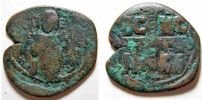
Anonymous Class C Follis, attributed to Michael IV.
Obverse: +EMMANOVHA. Christ Antiphonetes,
nimbate, standing facing / IC-XC-NI-KA divided by
jewelled cross. Coin #412
cars100
|
|

Syria Seleucia Pieria AE14
Apollo & tripod. Cop. 399, S 2184 Date: 100BC
Obverse: Head of Apollo right Reverse: Tripod
Size: 14.43 mm Weight: 2.3 grams Coin #621cars100
|
|

CONSTANTINE II, as Caesar. 317-337 AD. Ã Follis (22mm - 3.19 g). Trier mint. Struck 321 AD.
obv: CONSTANTINVS IVN NOB C, laureate and cuirassed bust left, holding Victory on a globe in right hand, mappa in left
rev: BEATA TRAN-QVILLITAS, globe set on altar inscribed VOT/IS/XX in three lines; PTR. RIC VII 312. EF, attractive brown patina.
ex VAuctions Sale : 213 Lot: 101, seller's pictureareich
|
|

An Anonymous Follis Class A 2 coin, type 21
Obverse: Christ facing, holding book of gospels IC to left XC to rightEmmanovha IC XC (God with us)
Reverse: +IhSYS XRISTYS bASILEY bASILE (Jesus Christ, King of Kings)
Sear attributes it to the joint reign of Basil II and Constantine VIII 1020-1028 AD
Grierson in DOC says Romanus III and into Michael IV's
|
|
|

The seller identified this as from Trier, but now that I see the mintmark a bit clearer, I am thinking maybe it's an official issue from Heraclea?Matthew W2
|
|
|
|
|
|

Tetricus I, Mint II, reverse FIDES MILITVM
IMP C P ESV TETRIC[VS AVG], Radiate, cuirassed bust right
FIDES MILITVM, Fides standing left with two standardsAdrianus
|
|
|
|
|

Trajan Limes Falsum?
Imitating a Dupondius, RIC 502 or RIC 591
Obv: IMP TRAIANO AVG GER DAC P M TR P COS V (VI?) P P
Apparently a double strike, which means that the coin was struck, not cast.
Rev: S P Q R OPTIMO PRINCIPI
Fortuna standing l., holding rudder and cornucopiae
28mm, 3.31gklausklage
|
|

Fourree Denarius, Severus Alexander, copying RIC 196
Obv: IMP SEV ALEXANDER AVG
Laureate head right, drapery on left shoulder
Double strike
Rev: FORTVNAE REDVCI
Fortuna standing left, holding rudder on globe and cornucopiae.
18mm, 3.04g
klausklage
|
|

Ptolemy III Euergetes. Ã Hemidrachm - Triobol. Alexandreia mint. First phase, struck circa 246-242/1. Diademed head of Zeus-Ammon right / Eagle standing left on thunderbolt, head right; cornucopia over shoulder; E between legs. Svoronos 974 var. (control mark).
AE40 about 46.5 g.
--------------------------------
Ar 0.249g, 6.7mm
Elea(Elia?), Aeolis, AR Hemiobol. Late 5th century BC. Head of Athena left, in crested helmet / E L A I, around olive wreath, all within incuse square. SNG Cop 164 ex ForvmRandygeki(h2)
|
|

Tetricus I, Mint II, reverse CONCORDIA MILITVM
IMP TE[TRIC]VS AVG, Radiate, cuirassed bust right
CONCORD[IA MI]LITVM, Concordia standing left with patera an cornucopia, standard behind
Normanby -
Weight 3.62g
A previously unknown issue which links typologically to Tetricus CONCORDIA AVG issues (Mint I) and FIDES MILITVM issues (Mint II) and Domitianus' CONCORDIA MILITVM type (Mint II).Adrianus
|
|
|
|
|
|
|

DN CONSTANTINVS PF AVG
New photo of one of my first coins. From an uncleaned lot.
I never did get around to attributing it!Jay GT4
|
|
|
|

Celtic, Bastarnae Tribe, Thrace, c. 220 - 160 B.C., Imitative of Macedonian Kingdom Type
The Bastarnae were an important ancient people of uncertain, but probably mixed Germanic-Celtic-Sarmatian, ethnic origin, who lived between the Danube and the Dnieper (Strabo, Geography, VII, 3,17) during the last centuries B.C. and early centuries A.D. The etymology of their name is uncertain, but may mean 'mixed-bloods' (compare 'bastard'), as opposed to their neighbours the East Germanic Scirii, the 'clean-' or 'pure-bloods.'
32899. Bronze AE 16, imitative of SNG Cop 1299 (Macedonian Kingdom, time of Philip V and Perseus, 221 - 168 B.C.), Fair/Fine, 2.168g, 16.3mm, obverse Celtic-style bust of river-god Strymon right; reverse TridentCastvlo
|
|

Islands of Thrace, Thasos
411-350BC, Trihemiobol. Obv. Kneeling Satyr with cup, Rev.ÎAΣ / IΩN - Amphora
Seaby 1755 , BMC. 3. 53-56Lee S
|
|

Belgien
Medaille 1909 (Bronze)
auf die Eröffnung der Klinik am 14.6.1909, finanziert durch die Gemeinschaftskasse von Industrie und Handel
Gewicht: 19,1g
Durchmesser: 34mm
Erhaltung: zaponiert, min.Rdf., vorzüglich _1298Antonivs Protti
|
|

Deutschland
Medaille o.J. 1990er Jahre (Kupfer-Nickel, vergoldet)
von Sir Roward Hill
auf Hans-Dietrich Genscher
Durchmesser: 39mm
Gewicht: 27,2g
Erhaltung: stempelglanz _290Antonivs Protti
|
|

GEORGIAN KINGDOM, QUEEN TAMAR (1184-1213 AD) Irregular copper coin. Obv.: Geometric designs, with legends in Georgian; including name T'amar. Rev.: Legends in Arabic letters. dpaul7
|
|

AUGUSTUS
AE As Rome Mint
25.7 mm, 10.3 grams
OBV: CEASER AUGUST PONT MAX TRIBVNIC POT, Bare head of Augustus right
REV: M MAECILIVS TVLLVS III VIR A A A F around large S C.
RIC-I-435
|
|
|
|

Preparing to trim down my collection to one portait of each Roman family member that I can find this is the third tray to the end of the third century.mauseus
|
|

Preparing to trim down my collection to one portait of each Roman family member that I can find this is the second tray, the first part of the third century. Compiled this tray then noticed that I'd forgotten to put in Trajan Decius (doh!).mauseus
|
|

Tripura, Udaya Manikya, Tanka, 11.16g, Sk 1489, citing Queen Hira, as previous lot, but border of arches on the obverse points right rather than left, no bead in front of lion, none of the date behind lion's back leg; reverse legend arranged slightly differently: Åri Åri Yutoda/ya Manikya/ Deva Åri Hi/ra Maha Devyau (RB. 136; KM. 79)Quant.Geek
|
|

Tripura, Amara Manikya, Tanka, 10.61g, Sk 1499, citing Queen Amaravati, similar to previous lot, but standard type 'k', small pellet in front of lion, and Åake divided by lion's front foot (RB. 161; KM. 90)Quant.Geek
|
|

Tripura, Rajadhara Manikya, Tanka, 10.58g, Sk 1508, citing Queen Satyavati, similar to previous lot but different standard (type 'p'?), and no bead to the left of it (RB. 178; KM. 97)Quant.Geek
|
|
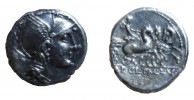
Denarius
Appius Claudius Pulcher, T Manlius Mancinus & Q Urbinus
Mint: Rome
111-110 BCE
Obverse: Helmeted head of Roma, right; behind, mark (circle within a triangle); border of dots
Reverse: Victory in triga right, holding reins in both hands, one horse looking back; AP CL T MAL Q VR in exergue; border of dots
Crawford (RRC) 299/1a
Sydenham 570
RSC I Mallia 1
SRCV I 176
|
|

Anonymous. Circa 270 BC. à Aes Grave Triens (48mm, 93.00 g, 12h). Rome mint. Head of horse right; [â¢â¢â¢â¢] (mark of value) below / Head of horse left; [â¢â¢â¢â¢] (mark of value) below. Crawford 18/3 (Uncertain mint); ICC 35; HN Italy 281. Fine, gray-green patina, some earthen deposits, a little flaky in parts.
From the Collection of a Director.ecoli
|
|
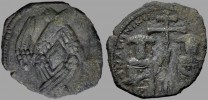
Andronicus II Palaeologus, with Michael IX. 1282-1328. Ã Assarion (19mm, 1.70 g, 6h). Class III. Constantinople mint. Struck 1295-1320. Winged seraph / Half-length facing figures of Andronicus and Michael, holding patriarchal cross between them. DOC 638-46; SB 2429. VF, green and brown patina.
From the Iconodule Collection.Quant.Geek
|
|

John Comnenus-Ducas. As emperor of Thessalonica, 1237-1242. BI Trachy (14mm, 0.38 g, 6h). Thessalonica mint. Facing bust of Christ Pantokrator / Facing busts John and St. Demetrius, holding patriarchal cross between them. DOC â; SB â; NAC 56, lot 830 (hammer 800 CHF). VF, dark green patina, obverse struck with worn die, ragged flan. Extremely rare.
From the Iconodule Collection.Quant.Geek
|
|

SIKH EMPIRE: AE ¼ anna (7.35g), Amritsar, VS(18)96, KM-5var, Herrli-01.31, small cross in obverse field, pa anna nanakshahi on reverse, lovely strike, gorgeous EF, R, ex Paul Stevens Collection. Herrli divided these into a paisa (=¼ anna) and half paisa (11-12g, and 5.5g, respectively), but all coins are inscribed "pa anna" for ¼ anna, and all weigh in the range of 7.0g to 8.5g; thus there is only one denomination for this type.
Quant.Geek
|
|
|
|
|

Heraclius & Heraclius Constantine overstruck on Phocas & Leontia . 610-641 / 602-610. à follis (26.89 mm, 8.78 g, 6 h). Host coin, Theopolis (Antioch) mint, 602-610 / after 610. overstrike, Thessalonica mint. Overstrike: fragmentary, d N hÃâRA[CLIçS PP AVG] �Host coin, also fragmentary, [O N FOCA] NÃâ PÃâ [AV] , Overstrike: Heraclius (on left, and Heraclius constantine, barely visible on right) standing facing, each holding globus cruciger, cross between their heads �Host coin: Phocas on left and Leontia standing facing; Emperor holds globus cruciger, Empress holds cruciform scepter; cross between their heads / Overstrike, large M between A / N / N / O and date (not struck-up), cross above, B below, ÃËÃâC in exergue�Host coin, large m between [A / N /] N / O and date (unclear) cross above, ThÃâçP' in exergue. Host coin, Cf. SBCV 671; Overstrike, Cf. SBCV 824. VF for type, dark green patina on devices, lighter encrustation on fields - overstrike at ~ 90º ccw. ��
multiply struck: host coin is Phocas & Leontia from Antioch, SBCV 671 or similar �overstrike, at ~ 90º ccw, is Heraclius from Thessalonica Quant.Geek
|
|

Divus Victorinus. Died A.D. 271. Ã antoninianus (21 mm, 2.99 g, 12 h). Colonia Agrippinensis, under Tetricus I, late A.D. 271. [DI]VO VICTORINO PIO, radiate and cuirassed bust of Victorinus right / CONSA[C]RATIO, eagle standing right on globe, head left, holding wreath in beak. Cf. RIC 85 (bust); cf. Mairat 416 (bust); AGK 1b. Brown patina with a few hard green depositsQuant.Geek
|
|

EDWARD IV
Edward IV was King of England from March 1461 to October 1470, and again from April 1471 until his sudden death in 1483. He was the first Yorkist King of England. The first half of his rule was marred by the violence associated with the Wars of the Roses, but he overcame the Lancastrian challenge to the throne at Tewkesbury in 1471 and there were no further rebellions in England during the rest of his reign.
In 1475, Edward declared war on France, landing at Calais in June. However, his ally Charles the Bold, Duke of Burgundy, failed to provide any significant military assistance leading Edward to undertake negotiations with the French, with whom he came to terms under the Treaty of Picquigny. France provided him with an immediate payment of 75,000 crowns and a yearly pension of 50,000 crowns, thus allowing him to "recoup his finances". Edward also backed an attempt by Alexander Stewart, 1st Duke of Albany and brother of King James III of Scotland, to take the Scottish throne in 1482. Edward's younger brother, the Duke of Gloucester (and future King Richard III) led an invasion of Scotland that resulted in the capture of Edinburgh and the Scottish king himself. Alexander Stewart, however, reneged on his agreement with Edward. The Duke of Gloucester then withdrew from his position in Edinburgh, though he did retain Berwick-upon-Tweed.
Edward became subject to an increasing number of ailments when his health began to fail and he fell fatally ill at Easter in 1483. He survived long enough though to add some codicils to his will, the most important being to name his brother Richard, Duke of Gloucester as Protector after his death. He died on 9th April 1483 and was buried in St George's Chapel, Windsor Castle. He was succeeded first by his twelve-year-old son Edward V of England, who was never crowned, and then by his brother who reigned as Richard III.
It is not known what actually caused Edward's death. Pneumonia, typhoid and poison have all been conjectured, but some have attributed his death to an unhealthy lifestyle because he had become stout and inactive in the years before his death.*Alex
|
|

JAMES IV OF SCOTLAND
James IV was the King of Scotland from June 1488 until his death in battle at the age of 40 on the 9th September, 1513.
James IV's mother, Margaret of Denmark, was more popular than his father, James III, and though somewhat estranged from her husband she raised their sons at Stirling Castle until she died in 1486. Two years later, a rebellion broke out, where the rebels set up the 15-year-old Prince James as their nominal leader. The rebels fought James III at the Battle of Sauchieburn where, on 11th June 1488, the king was killed. Prince James assumed the throne as James IV and was crowned at Scone on 24th of June. However he continued to bear an intense guilt for the indirect role which he had played in the death of his father.
James maintained Scotland's traditional good relations with France, and this occasionally created diplomatic problems with England, but James recognised nonetheless that peace between Scotland and England was in the interest of both countries, and established good diplomatic relations with England as well. First he ratified the Treaty of Ayton in 1497, then, in 1502 James signed the Treaty of Perpetual Peace with Henry VII which was sealed by his marriage to Henry's daughter Margaret Tudor the next year. Anglo-Scottish relations generally remained stable until the death of Henry VII in 1509.
James saw the importance of building a fleet that could provide Scotland with a strong maritime presence, he founded two new dockyards and acquired a total of 38 ships for the Royal Scots Navy. These including the "Great Michael" which, built at great expense, was launched in 1511 and was at that time the largest ship in the world.
When war broke out between England and France, James found himself in a difficult position as an ally by treaty to both countries. But relations with England had worsened since the accession of Henry VIII, and when Henry invaded France, James reacted by declaring war on England.
James sent the Scottish navy, including the "Great Michael", to join the ships of Louis XII of France and, hoping to take advantage of Henry's absence at the siege of Thérouanne, he himself led an invading army southward into Northumberland. However, on 9th September 1513 at the disastrous Battle of Flodden James IV was killed, he was the last monarch in Great Britain to be killed in battle. His death, along with many of his nobles including his son the archbishop of St Andrews, was one of the worst military defeats in Scotland's history and the loss of such a large portion of the political community was a major blow to the realm. James IV's corpse was identified after the battle and taken to Berwick, where it was embalmed and placed in a lead coffin before being transported to London. Catherine of Aragon, wife of Henry VIII, sent the dead king's slashed, blood-stained surcoat to Henry, who was fighting in France, with the recommendation that he use it as a war banner.
James IV's son, James V, was crowned three weeks after the disaster at Flodden, but he was not yet two years old, and his minority was to be fraught with political upheaval.*Alex
|
|

HENRY VII
Henry VII was the King of England from 22 August 1485 until his death in 1509. He was the first monarch of the House of Tudor.
Henry's mother, Margaret Beaufort, was a descendant of the Lancastrian branch of the House of Plantagenet. Henry's father, Edmund Tudor, 1st Earl of Richmond, a half-brother of Henry VI of England, died three months before his son Henry was born. During Henry's early years, his uncle Henry VI fought against Edward IV, a member of the Yorkist Plantagenet branch. After Edward re-took the throne in 1471, Henry Tudor spent 14 years in exile in Brittany. Henry attained the throne when his forces, supported by France and Scotland, defeated Edward IV's brother Richard III at the Battle of Bosworth Field, the culmination of the Wars of the Roses. He cemented his claim to the throne by marrying Elizabeth of York, daughter of King Edward IV. Henry VII was the last king of England to win his throne on the field of battle.
Henry was successful in restoring power and stability to the English monarchy following the civil war and he is credited with a number of administrative, economic and diplomatic initiatives. His support of England's wool industry had long-lasting benefit to the whole English economy. He paid very close attention to detail, and instead of spending lavishly he concentrated on raising new revenues. Henry's new taxes stabilised the government's finances but, after his death, a commission found there had been widespread abuses in the tax collection process.
Henry VII reigned for nearly 24 years. He died of tuberculosis at Richmond Palace on 21 April 1509 and was buried in the chapel he commissioned in Westminster Abbey next to his wife, Elizabeth. His mother survived him, but she died two months later on 29 June 1509.
Henry VII was succeeded by his second son, Henry VIII.*Alex
|
|

CARDINAL WOLSEY
When Henry VIII became King of England in 1509 he appointed Thomas Wolsey to the post of Almoner, a position that gave him a seat on the Privy Council and an opportunity for establishing a personal rapport with the King to such an extent that by 1514 Wolsey had become the controlling figure in virtually all matters of state. In 1515, he was awarded the title Archbishop of York and this, followed by his appointment that same year as Cardinal by Pope Leo X, gave him precedence over all other English clerics. His ecclesiastical power advanced even further in 1523 when the Bishop of Durham, a post with wide political powers, was added to his titles.
After Wolsey attained the position of Lord Chancellor, the King's chief adviser, he had achieved more power than any other Crown servant in English history and during his fourteen years of chancellorship Wolsey, who was often alluded to as an alter rex (other king), used his power to neutralise the influence of anyone who might threaten his position..
In spite of having made many enemies, Cardinal Wolsey retained Henry VIII's confidence until, in 1527, the King decided to seek an annulment of his marriage to Catherine of Aragon so that he could marry Anne Boleyn. Henry asked Wolsey to negotiate the annulment with the Pope and in 1528 the Pope decided to allow two papal legates, Wolsey himself and Cardinal Campeggio, to decide the outcome in England. Wolsey was confident of the outcome, but Campeggio took a long time to arrive, and then he delayed proceedings so much, that the case had to be suspended and the Pope decided that the official decision should therefore be made in Rome and not in England.
After his failure to negotiate the annulment, Wolsey fell out of favour with Henry and in 1529 he was stripped of his government office and property, including the magnificent Palace of Hampton Court, which Henry took as his own main London residence.
Wolsey was however permitted to retain the title of Archbishop of York and so he travelled to Yorkshire, for the first time in his career, to carry out those duties.
Now that he was no longer protected by Henry, Wolsey's enemies, including it is rumoured, Ann Boleyn, conspired against him and Henry had him arrested and recalled to London to answer to charges of treason, one of those being that with 'pompous and preposterous mind, he had enterprised to join and imprint the Cardinal's hat under the King's arms on the King's coin of groats made in the city of York'. But Wolsey, now in great distress, fell ill on the journey back to the capital and at Leicester, on 29 November 1530, aged about 57, he died from natural causes before he could be beheaded.*Alex
|
|

Ptolemy/Selukid AE22 didrachm8.53g. Demetrios II / David C13
|
|
|
|
|
|
|
|
|
|
|
|
|
|

MARY QUEEN OF SCOTS
Mary I is one of the most well known, romantic and tragic figures in Scottish history. She was the only surviving child of King James V of Scotland and became queen on the death of her father when she was only six or seven days old. Mary was brought up in the Catholic faith and educated in France along with the French royal children, while Scotland was ruled in her name by regents, principally the Earl of Arran. In 1558 Mary married the French Dauphin, Francis, and following his accession in 1559 she became Queen consort of France and he King consort of Scotland. However, when Francis died in 1560 Mary was devastated and in 1561 she returned to Scotland. Four years later, in 1565, she married her half-cousin, Lord Darnley and the following year she bore him a son, who would later become James I of England. When in 1567, Darnley's house in Edinburgh was destroyed by an explosion and he was found murdered in the grounds, suspicion implicated Mary and her favourite, the Earl of Bothwell. When later that same year Mary married Bothwell those suspicions were not allayed, and following an uprising against her, she was imprisoned in Loch Leven Castle and forced to abdicate in favour of her one year old son. After an unsuccessful attempt to regain her throne and defeat at the battle of Langside in 1568, Mary fled south to England, only to be imprisoned by Elizabeth I who perceived her as a threat to the throne of England. For over eighteen years Elizabeth had Mary confined in various castles and manor houses throughout England until, in 1587, after being accused of numerous intrigues and plots against Elizabeth, Mary was beheaded at Fotheringhay Castle.*Alex
|
|

JAMES III
James III was crowned at Kelso Abbey in 1460 at the age of nine, he was the son of James II and Mary of Guelders. During his childhood, the government was led by successive factions until 1469 when he began to rule for himself. That same year he married Princess Margaret of Denmark. Margaret's father, King Christian I of Denmark and Norway was unable to raise the full amount of her dowry so pledged his lands and rights in Orkney and Shetland as security for the remainder. But Christian I was never able to redeem his pledge, and Orkney and Shetland have remained Scottish possessions ever since.
Soon after his marriage, James faced great difficulties in restoring a strong central government. His preference for the company of scholars, architects and artists coupled with his extravagance and partiality to favourites alienated him from the loyalty of his nobles. Even his own brothers, Alexander, Duke of Albany and John, Earl of Mar regarded him with jealousy verging on hatred. In 1479, James' brothers were arrested on suspicion of conspiring against the Crown. John Stewart, the Earl of Mar, died in suspicious circumstances, whilst Alexander Stewart, the Duke of Albany, escaped and fled to England.
The ever-present English threat had been temporarily solved by a truce with Edward IV in 1463 but James' estrangement from his brothers and a strong faction within the Scottish nobility led to the final loss of Berwick.
Although James had tried to settle his differences with Alexander, Duke of Albany, his brother again tried to take his throne in a coup after Edward IV recognised him as Alexander IV of Scotland in 1482. Some minor members of James III's household were hanged, including Robert Cochrane, the king's favourite. But James was removed to Edinburgh Castle where he survived and Alexander was exiled to France.
After his queen's death in 1486, James lived in increasing isolation amidst the growing resentment of the nobility. Finally, in 1488, the Scottish nobles seized James' eldest son, also called James, placed him at their head, and rose against the king. At the Battle of Sauchieburn, three miles from Stirling, James III, defeated, was thrown from his horse as he fled from the field. He was carried into a nearby cottage where he was set upon and stabbed to death.
James III was buried at Cambuskenneth Abbey near Stirling and his son, the figurehead of the revolt against him, was hailed as James IV.
*Alex
|
|

Domitian. A.D. 81-96. AR denarius (18 mm, 3.38 g, 7 h). Rome, A.D. 88/9. IMP CAES DOMIT AVG GERM P M TR P VIII, laureate head of Domitian right / IMP XIX COS XIIII CENS P P P, Minerva advancing right, holding shield and wielding javelin. RIC 667: BN 145; BMC 151; RSC 252. Ex:Triskeles Auctions Sale 31, lot 190, March 27, 2020paul1888
|
|

Rome. Vespasian (AD 69-79). AR denarius (3.52 gm). Rome, AD 79. Laureate head of Vespasian right / Capricorn left; below, globe. RIC 1058. Ex: CNG 42, lot 42, 1997; Ex: CNG Triton VI, lot 836, 1/13/2003; Ex: NAC 92, lot 2240, 5/23/16; Heritage Auctions, Auction 3036, lot 33400, 1/16/2018paul1888
|
|

Domitian. A.D. 81-96. AR denarius (18 mm, 3.41 g, 6 h). Rome, A.D. 81. IMP CAES DOMITIANVS AVG P M, laureate head of Domitian right / TR P COS VII DES VIII P P, tripod with dolphin above, no raven below. RIC 74; BN 19; BMC 22; cf. RSC 568c (ravens below). Ex: Triskeles Auctions, Auction 32, lot 185, March 27, 2020paul1888
|
|

BERIA, Bolskan. Circa 150-100 BC. AR Denarius (17.5mm, 4.05 g, 1h). Bare bearded head right; Iberian bon to left / Warrior, holding spear, on horseback right; Iberian bolÅkan below. ACIP 1417; SNG BM Spain 710â33. Ex. Triton XX, lot 1, 1/10/2017 (unsold), ex: CNG Electronic Auction 412, lot 1, 1/17/2018.paul1888
|
|
|
|
|
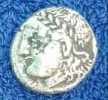
KYRENAICA. Kyrene. AR Didrachm (7.69 gms), ca. 305-300 B.C. CHOICE VERY FINE. SNG Cop-1238; BMC-238. Obverse: Head Zeus Karneios left; Reverse: Silphium plant; monogram to left, star to right. Though rather intensely cleaned, this piece nevertheless offers a solid strike and a pleasing representation of the silphium plant--harvested to extinction in antiquity.
|
|

EGYPT. Alexandria. Domitian, 81-96. Diobol
(25 mm, 7.42 g, 11 h),
Obv: RY 10 = 90/1. [ÎΥΤ] ÎÎÎϹÎΡ ÎÎÎÎΤ [ϹÐÎ ÎÐΡÎ] Laureate head of Domitian to right, with aegis on his left shoulder.
Rev: L I Agathodaemon serpent riding horse to right.
Dattari (Savio) 563. Emmett 276.10. K&G 24.110. RPC II 2584A.
Extremely rare. Somewhat porous and with light deposits, otherwise, good fine.
From a European collection, formed before 2005.
Leu Numismatic Web auction 17 Lot 2103 Sunday August 15, 2021
I was first made aware of this coin a few years ago. Ever since, I have trying to grab one when they come up at auctions. The problem is 2-fold. First, it is a rare type. If the attribution of RPC 2854A is correct, it is even rarer than RPC 2854 which is on its own a rare coin. RPC online has my coin as RPC 2854 but I am not sure they are correct. The presence or absence of Aegis on the bust seems to be the key factor in differentiating these types.
I have found that I am attracted to the Alexandrian bronzes struck for Domitian. So many of the Egyptian themed coins are interesting and are a real departure from the reverses of the imperial coinage from the same time period.
Rarity aside it is the reverse of this coin that really shines. A coin that depicts a snake riding a horse? Yes, I will take one of those please. The reverse is so interesting that there is more demand for this type than the current supply. I consider myself lucky to add this fascinating type to my collection.
From the auction description: âAccording to Emmett, the reverse of this interesting issue is connected to the grain harvest. The horse represents the continuous cycle of the seasons, while Agathodaemon ensures that the grain will sprout, thus ensuring Egypt's prosperity.â
orfew
|
|
| 15610 files on 174 page(s) |
1 |
 |
 |
 |
 |
|

|
